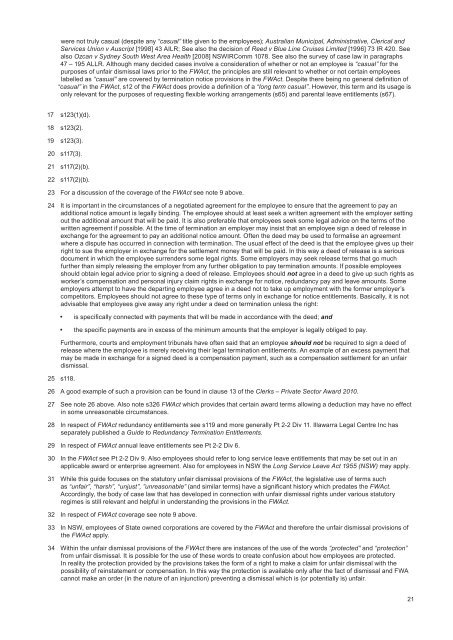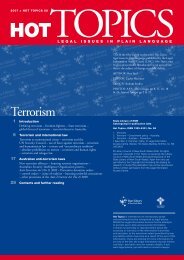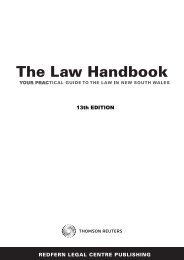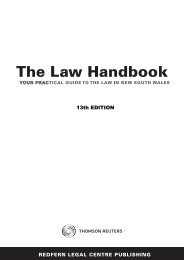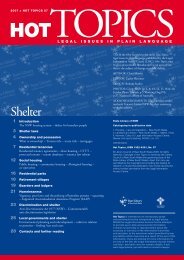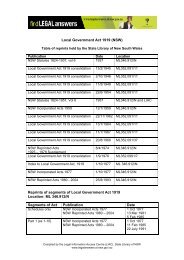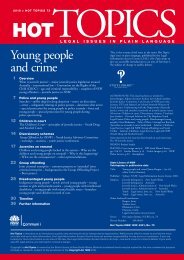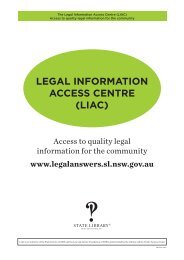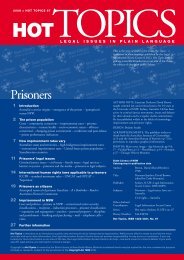Guide to termination and unfair dismissal rights of - Legal ...
Guide to termination and unfair dismissal rights of - Legal ...
Guide to termination and unfair dismissal rights of - Legal ...
- No tags were found...
You also want an ePaper? Increase the reach of your titles
YUMPU automatically turns print PDFs into web optimized ePapers that Google loves.
were not truly casual (despite any “casual” title given <strong>to</strong> the employees); Australian Municipal, Administrative, Clerical <strong>and</strong>Services Union v Auscript [1998] 43 AILR; See also the decision <strong>of</strong> Reed v Blue Line Cruises Limited [1996] 73 IR 420. Seealso Ozcan v Sydney South West Area Health [2008] NSWIRComm 1078. See also the survey <strong>of</strong> case law in paragraphs47 – 195 ALLR. Although many decided cases involve a consideration <strong>of</strong> whether or not an employee is “casual” for thepurposes <strong>of</strong> <strong>unfair</strong> <strong>dismissal</strong> laws prior <strong>to</strong> the FWAct, the principles are still relevant <strong>to</strong> whether or not certain employeeslabelled as “casual” are covered by <strong>termination</strong> notice provisions in the FWAct. Despite there being no general definition <strong>of</strong>“casual” in the FWAct, s12 <strong>of</strong> the FWAct does provide a definition <strong>of</strong> a “long term casual”. However, this term <strong>and</strong> its usage isonly relevant for the purposes <strong>of</strong> requesting flexible working arrangements (s65) <strong>and</strong> parental leave entitlements (s67).17 s123(1)(d).18 s123(2).19 s123(3).20 s117(3).21 s117(2)(b).22 s117(2)(b).23 For a discussion <strong>of</strong> the coverage <strong>of</strong> the FWAct see note 9 above.24 It is important in the circumstances <strong>of</strong> a negotiated agreement for the employee <strong>to</strong> ensure that the agreement <strong>to</strong> pay anadditional notice amount is legally binding. The employee should at least seek a written agreement with the employer settingout the additional amount that will be paid. It is also preferable that employees seek some legal advice on the terms <strong>of</strong> thewritten agreement if possible. At the time <strong>of</strong> <strong>termination</strong> an employer may insist that an employee sign a deed <strong>of</strong> release inexchange for the agreement <strong>to</strong> pay an additional notice amount. Often the deed may be used <strong>to</strong> formalise an agreementwhere a dispute has occurred in connection with <strong>termination</strong>. The usual effect <strong>of</strong> the deed is that the employee gives up theirright <strong>to</strong> sue the employer in exchange for the settlement money that will be paid. In this way a deed <strong>of</strong> release is a seriousdocument in which the employee surrenders some legal <strong>rights</strong>. Some employers may seek release terms that go muchfurther than simply releasing the employer from any further obligation <strong>to</strong> pay <strong>termination</strong> amounts. If possible employeesshould obtain legal advice prior <strong>to</strong> signing a deed <strong>of</strong> release. Employees should not agree in a deed <strong>to</strong> give up such <strong>rights</strong> asworker’s compensation <strong>and</strong> personal injury claim <strong>rights</strong> in exchange for notice, redundancy pay <strong>and</strong> leave amounts. Someemployers attempt <strong>to</strong> have the departing employee agree in a deed not <strong>to</strong> take up employment with the former employer’scompeti<strong>to</strong>rs. Employees should not agree <strong>to</strong> these type <strong>of</strong> terms only in exchange for notice entitlements. Basically, it is notadvisable that employees give away any right under a deed on <strong>termination</strong> unless the right:• is specifically connected with payments that will be made in accordance with the deed; <strong>and</strong>• the specific payments are in excess <strong>of</strong> the minimum amounts that the employer is legally obliged <strong>to</strong> pay.Furthermore, courts <strong>and</strong> employment tribunals have <strong>of</strong>ten said that an employee should not be required <strong>to</strong> sign a deed <strong>of</strong>release where the employee is merely receiving their legal <strong>termination</strong> entitlements. An example <strong>of</strong> an excess payment thatmay be made in exchange for a signed deed is a compensation payment, such as a compensation settlement for an <strong>unfair</strong><strong>dismissal</strong>.25 s118.26 A good example <strong>of</strong> such a provision can be found in clause 13 <strong>of</strong> the Clerks – Private Sec<strong>to</strong>r Award 2010.27 See note 26 above. Also note s326 FWAct which provides that certain award terms allowing a deduction may have no effectin some unreasonable circumstances.28 In respect <strong>of</strong> FWAct redundancy entitlements see s119 <strong>and</strong> more generally Pt 2-2 Div 11. Illawarra <strong>Legal</strong> Centre Inc hasseparately published a <strong>Guide</strong> <strong>to</strong> Redundancy Termination Entitlements.29 In respect <strong>of</strong> FWAct annual leave entitlements see Pt 2-2 Div 6.30 In the FWAct see Pt 2-2 Div 9. Also employees should refer <strong>to</strong> long service leave entitlements that may be set out in anapplicable award or enterprise agreement. Also for employees in NSW the Long Service Leave Act 1955 (NSW) may apply.31 While this guide focuses on the statu<strong>to</strong>ry <strong>unfair</strong> <strong>dismissal</strong> provisions <strong>of</strong> the FWAct, the legislative use <strong>of</strong> terms suchas “<strong>unfair</strong>”, “harsh”, “unjust”, ”unreasonable” (<strong>and</strong> similar terms) have a significant his<strong>to</strong>ry which predates the FWAct.Accordingly, the body <strong>of</strong> case law that has developed in connection with <strong>unfair</strong> <strong>dismissal</strong> <strong>rights</strong> under various statu<strong>to</strong>ryregimes is still relevant <strong>and</strong> helpful in underst<strong>and</strong>ing the provisions in the FWAct.32 In respect <strong>of</strong> FWAct coverage see note 9 above.33 In NSW, employees <strong>of</strong> State owned corporations are covered by the FWAct <strong>and</strong> therefore the <strong>unfair</strong> <strong>dismissal</strong> provisions <strong>of</strong>the FWAct apply.34 Within the <strong>unfair</strong> <strong>dismissal</strong> provisions <strong>of</strong> the FWAct there are instances <strong>of</strong> the use <strong>of</strong> the words “protected” <strong>and</strong> “protection”from <strong>unfair</strong> <strong>dismissal</strong>. It is possible for the use <strong>of</strong> these words <strong>to</strong> create confusion about how employees are protected.In reality the protection provided by the provisions takes the form <strong>of</strong> a right <strong>to</strong> make a claim for <strong>unfair</strong> <strong>dismissal</strong> with thepossibility <strong>of</strong> reinstatement or compensation. In this way the protection is available only after the fact <strong>of</strong> <strong>dismissal</strong> <strong>and</strong> FWAcannot make an order (in the nature <strong>of</strong> an injunction) preventing a <strong>dismissal</strong> which is (or potentially is) <strong>unfair</strong>.21


